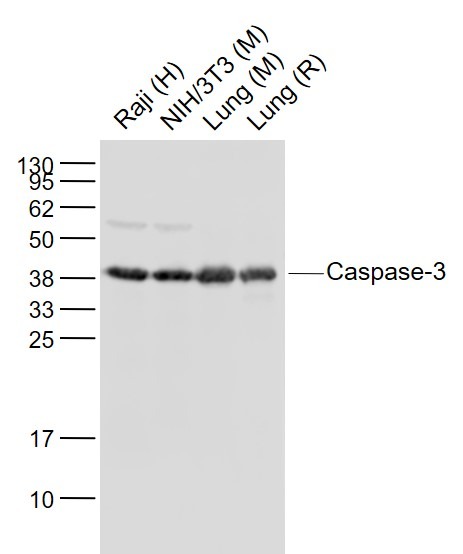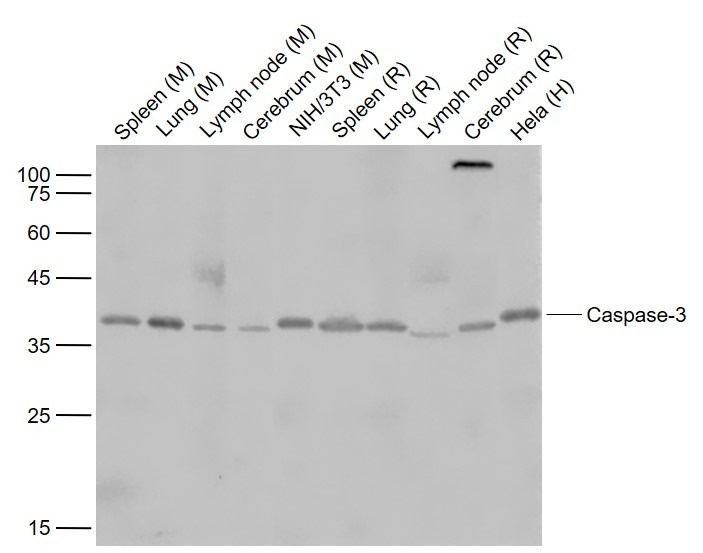Shopping Cart
Remove All Your shopping cart is currently empty
Your shopping cart is currently empty
Anti-Caspase-3 Polyclonal Antibody is a Rabbit antibody targeting Caspase-3. Anti-Caspase-3 Polyclonal Antibody can be used in ELISA,WB.
| Pack Size | Price | USA Warehouse | Global Warehouse | Quantity |
|---|---|---|---|---|
| 50 μL | $220 | 7-10 days | 7-10 days | |
| 100 μL | $372 | 7-10 days | 7-10 days |
| Description | Anti-Caspase-3 Polyclonal Antibody is a Rabbit antibody targeting Caspase-3. Anti-Caspase-3 Polyclonal Antibody can be used in ELISA,WB. |
| Synonyms | Yama, SCA-1, CPP32B, CPP32, apopain |
| Ig Type | IgG |
| Reactivity | Human,Mouse,Rat |
| Verified Activity | 1. Sample: Lane 1: Raji (Human) Cell Lysate at 30 μg Lane 2: NIH/3T3 (Mouse) Cell Lysate at 30 μg Lane 3: Lung (Mouse) Lysate at 40 μg Lane 4: Lung (Rat) Lysate at 40 μg Primary: Anti-Caspase-3 (TMAB-00285) at 1/1000 dilution Secondary: IRDye800CW Goat Anti-Rabbit IgG at 1/20000 dilution Predicted band size: 35 kDa Observed band size: 37 kDa 2. Sample: Lane 1: Spleen (Mouse) Lysate at 40 μg Lane 2: Lung (Mouse) Lysate at 40 μg Lane 3: LympHnode (Mouse) Lysate at 40 μg Lane 4: Cerebrum (Mouse) Lysate at 40 μg Lane 5: NIH/3T3 (Mouse) Cell Lysate at 30 μg Lane 6: Spleen (Rat) Lysate at 40 μg Lane 7: Lung (Rat) Lysate at 40 μg Lane 8: LympHnode (Rat) Lysate at 40 μg Lane 9: Cerebrum (Rat) Lysate at 40 μg Lane 10: Hela (Human) Cell Lysate at 30 μg Primary: Anti-Caspase-3 (TMAB-00285) at 1/1000 dilution Secondary: IRDye800CW Goat Anti-Rabbit IgG at 1/20000 dilution Predicted band size: 35 kDa Observed band size: 37 kDa   |
| Application | |
| Recommended Dose | WB: 1:500-2000; ELISA: 1:5000-10000 |
| Antibody Type | Polyclonal |
| Host Species | Rabbit |
| Subcellular Localization | Cytoplasm. |
| Tissue Specificity | Highly expressed in lung, spleen, heart, liver and kidney. Moderate levels in brain and skeletal muscle, and low in testis. Also found in many cell lines, highest expression in cells of the immune system. |
| Construction | Polyclonal Antibody |
| Purification | Protein A purified |
| Appearance | Liquid |
| Formulation | 0.01M TBS (pH7.4) with 1% BSA, 0.02% Proclin300 and 50% Glycerol. |
| Concentration | 1 mg/mL |
| Research Background | The caspase family of cysteine proteases play a key role in apoptosis. Caspase 3 is the most extensively studied apoptotic protein among caspase family members. Caspase 3 is synthesized as inactive pro enzyme that is processed in cells undergoing apoptosis by self proteolysis and/or cleavage by other upstream proteases (e.g. Caspases 8, 9 and 10). The processed form of Caspase 3 consists of large (17kDa) and small (12kDa) subunits which associate to form an active enzyme. Caspase 3 is cleaved at Asp28 Ser29 and Asp175 Ser176. The active Caspase 3 proteolytically cleaves and activates other caspases (e.g. Caspases 6, 7 and 9), as well as relevant targets in the cells (e.g. PARP and DFF). Alternative splicing of this gene results in two transcript variants which encode the same protein. In immunohistochemical studies Caspase 3 expression has been shown to be widespread but not present in all cell types (e.g. commonly reported in epithelial cells of skin, renal proximal tubules and collecting ducts). Differences in the level of Caspase 3 have been reported in cells of short lived nature (eg germinal centre B cells) and those that are long lived (eg mantle zone B cells). Caspase 3 is the predominant caspase involved in the cleavage of amyloid beta 4A precursor protein, which is associated with neuronal death in Alzheimer's disease. |
| Immunogen | KLH conjugated synthetic peptide: human caspase-3 p17 subunit |
| Antigen Species | Human |
| Gene Name | CASP3 |
| Gene ID | |
| Protein Name | Caspase-3 |
| Uniprot ID | |
| Biology Area | Caspases,Metabolism,Caspases,Caspases,Other proteases,Apoptosis |
| Function | Involved in the activation cascade of caspases responsible for apoptosis execution. At the onset of apoptosis it proteolytically cleaves poly(ADP-ribose) polymerase (PARP) at a '216-Asp-|-Gly-217' bond. Cleaves and activates sterol regulatory element binding proteins (SREBPs) between the basic helix-loop-helix leucine zipper domain and the membrane attachment domain. Cleaves and activates caspase-6, -7 and -9. Involved in the cleavage of huntingtin. Triggers cell adhesion in sympathetic neurons through RET cleavage. |
| Molecular Weight | Theoretical: 17/32 kDa. |
| Stability & Storage | Store at -20°C or -80°C for 12 months. Avoid repeated freeze-thaw cycles. |
| Transport | Shipping with blue ice. |
| Size | Quantity | Unit Price | Amount | Operation |
|---|

Copyright © 2015-2025 TargetMol Chemicals Inc. All Rights Reserved.